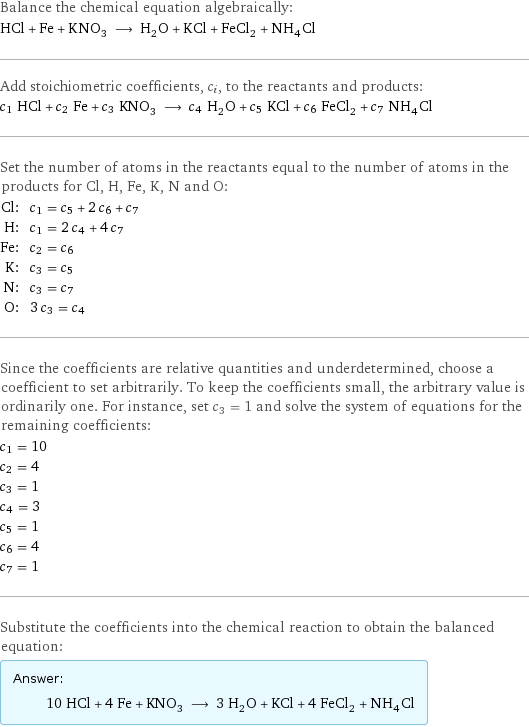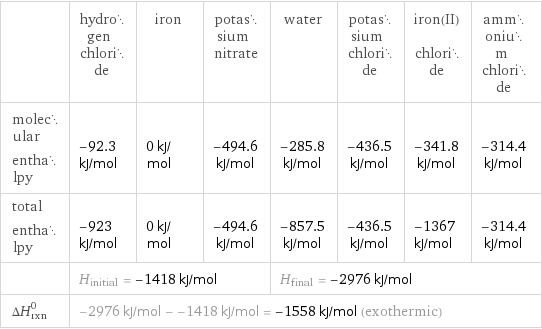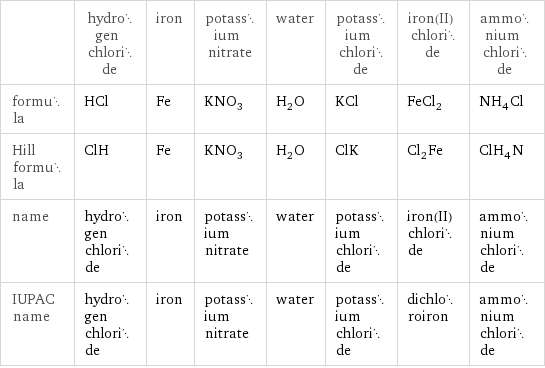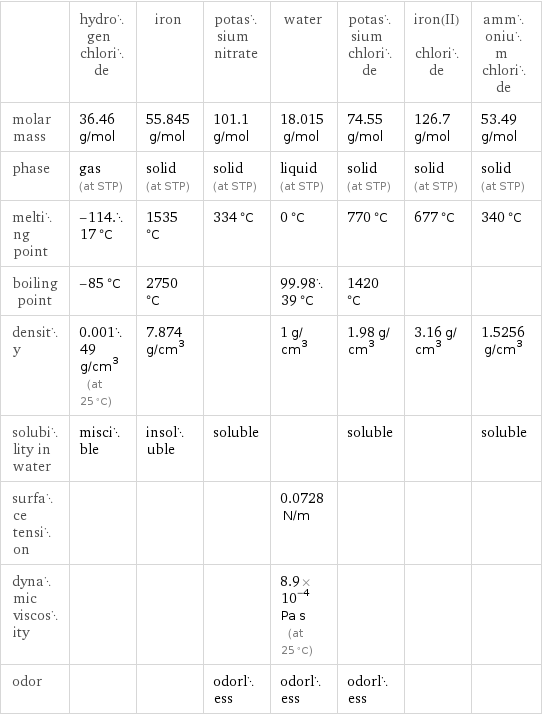Input interpretation

HCl hydrogen chloride + Fe iron + KNO_3 potassium nitrate ⟶ H_2O water + KCl potassium chloride + FeCl_2 iron(II) chloride + NH_4Cl ammonium chloride
Balanced equation

Balance the chemical equation algebraically: HCl + Fe + KNO_3 ⟶ H_2O + KCl + FeCl_2 + NH_4Cl Add stoichiometric coefficients, c_i, to the reactants and products: c_1 HCl + c_2 Fe + c_3 KNO_3 ⟶ c_4 H_2O + c_5 KCl + c_6 FeCl_2 + c_7 NH_4Cl Set the number of atoms in the reactants equal to the number of atoms in the products for Cl, H, Fe, K, N and O: Cl: | c_1 = c_5 + 2 c_6 + c_7 H: | c_1 = 2 c_4 + 4 c_7 Fe: | c_2 = c_6 K: | c_3 = c_5 N: | c_3 = c_7 O: | 3 c_3 = c_4 Since the coefficients are relative quantities and underdetermined, choose a coefficient to set arbitrarily. To keep the coefficients small, the arbitrary value is ordinarily one. For instance, set c_3 = 1 and solve the system of equations for the remaining coefficients: c_1 = 10 c_2 = 4 c_3 = 1 c_4 = 3 c_5 = 1 c_6 = 4 c_7 = 1 Substitute the coefficients into the chemical reaction to obtain the balanced equation: Answer: | | 10 HCl + 4 Fe + KNO_3 ⟶ 3 H_2O + KCl + 4 FeCl_2 + NH_4Cl
Structures

+ + ⟶ + + +
Names

hydrogen chloride + iron + potassium nitrate ⟶ water + potassium chloride + iron(II) chloride + ammonium chloride
Reaction thermodynamics
Enthalpy

| hydrogen chloride | iron | potassium nitrate | water | potassium chloride | iron(II) chloride | ammonium chloride molecular enthalpy | -92.3 kJ/mol | 0 kJ/mol | -494.6 kJ/mol | -285.8 kJ/mol | -436.5 kJ/mol | -341.8 kJ/mol | -314.4 kJ/mol total enthalpy | -923 kJ/mol | 0 kJ/mol | -494.6 kJ/mol | -857.5 kJ/mol | -436.5 kJ/mol | -1367 kJ/mol | -314.4 kJ/mol | H_initial = -1418 kJ/mol | | | H_final = -2976 kJ/mol | | | ΔH_rxn^0 | -2976 kJ/mol - -1418 kJ/mol = -1558 kJ/mol (exothermic) | | | | | |
Equilibrium constant
![Construct the equilibrium constant, K, expression for: HCl + Fe + KNO_3 ⟶ H_2O + KCl + FeCl_2 + NH_4Cl Plan: • Balance the chemical equation. • Determine the stoichiometric numbers. • Assemble the activity expression for each chemical species. • Use the activity expressions to build the equilibrium constant expression. Write the balanced chemical equation: 10 HCl + 4 Fe + KNO_3 ⟶ 3 H_2O + KCl + 4 FeCl_2 + NH_4Cl Assign stoichiometric numbers, ν_i, using the stoichiometric coefficients, c_i, from the balanced chemical equation in the following manner: ν_i = -c_i for reactants and ν_i = c_i for products: chemical species | c_i | ν_i HCl | 10 | -10 Fe | 4 | -4 KNO_3 | 1 | -1 H_2O | 3 | 3 KCl | 1 | 1 FeCl_2 | 4 | 4 NH_4Cl | 1 | 1 Assemble the activity expressions accounting for the state of matter and ν_i: chemical species | c_i | ν_i | activity expression HCl | 10 | -10 | ([HCl])^(-10) Fe | 4 | -4 | ([Fe])^(-4) KNO_3 | 1 | -1 | ([KNO3])^(-1) H_2O | 3 | 3 | ([H2O])^3 KCl | 1 | 1 | [KCl] FeCl_2 | 4 | 4 | ([FeCl2])^4 NH_4Cl | 1 | 1 | [NH4Cl] The equilibrium constant symbol in the concentration basis is: K_c Mulitply the activity expressions to arrive at the K_c expression: Answer: | | K_c = ([HCl])^(-10) ([Fe])^(-4) ([KNO3])^(-1) ([H2O])^3 [KCl] ([FeCl2])^4 [NH4Cl] = (([H2O])^3 [KCl] ([FeCl2])^4 [NH4Cl])/(([HCl])^10 ([Fe])^4 [KNO3])](../image_source/870190d4053962740bb7ea620dd9daa2.png)
Construct the equilibrium constant, K, expression for: HCl + Fe + KNO_3 ⟶ H_2O + KCl + FeCl_2 + NH_4Cl Plan: • Balance the chemical equation. • Determine the stoichiometric numbers. • Assemble the activity expression for each chemical species. • Use the activity expressions to build the equilibrium constant expression. Write the balanced chemical equation: 10 HCl + 4 Fe + KNO_3 ⟶ 3 H_2O + KCl + 4 FeCl_2 + NH_4Cl Assign stoichiometric numbers, ν_i, using the stoichiometric coefficients, c_i, from the balanced chemical equation in the following manner: ν_i = -c_i for reactants and ν_i = c_i for products: chemical species | c_i | ν_i HCl | 10 | -10 Fe | 4 | -4 KNO_3 | 1 | -1 H_2O | 3 | 3 KCl | 1 | 1 FeCl_2 | 4 | 4 NH_4Cl | 1 | 1 Assemble the activity expressions accounting for the state of matter and ν_i: chemical species | c_i | ν_i | activity expression HCl | 10 | -10 | ([HCl])^(-10) Fe | 4 | -4 | ([Fe])^(-4) KNO_3 | 1 | -1 | ([KNO3])^(-1) H_2O | 3 | 3 | ([H2O])^3 KCl | 1 | 1 | [KCl] FeCl_2 | 4 | 4 | ([FeCl2])^4 NH_4Cl | 1 | 1 | [NH4Cl] The equilibrium constant symbol in the concentration basis is: K_c Mulitply the activity expressions to arrive at the K_c expression: Answer: | | K_c = ([HCl])^(-10) ([Fe])^(-4) ([KNO3])^(-1) ([H2O])^3 [KCl] ([FeCl2])^4 [NH4Cl] = (([H2O])^3 [KCl] ([FeCl2])^4 [NH4Cl])/(([HCl])^10 ([Fe])^4 [KNO3])
Rate of reaction
![Construct the rate of reaction expression for: HCl + Fe + KNO_3 ⟶ H_2O + KCl + FeCl_2 + NH_4Cl Plan: • Balance the chemical equation. • Determine the stoichiometric numbers. • Assemble the rate term for each chemical species. • Write the rate of reaction expression. Write the balanced chemical equation: 10 HCl + 4 Fe + KNO_3 ⟶ 3 H_2O + KCl + 4 FeCl_2 + NH_4Cl Assign stoichiometric numbers, ν_i, using the stoichiometric coefficients, c_i, from the balanced chemical equation in the following manner: ν_i = -c_i for reactants and ν_i = c_i for products: chemical species | c_i | ν_i HCl | 10 | -10 Fe | 4 | -4 KNO_3 | 1 | -1 H_2O | 3 | 3 KCl | 1 | 1 FeCl_2 | 4 | 4 NH_4Cl | 1 | 1 The rate term for each chemical species, B_i, is 1/ν_i(Δ[B_i])/(Δt) where [B_i] is the amount concentration and t is time: chemical species | c_i | ν_i | rate term HCl | 10 | -10 | -1/10 (Δ[HCl])/(Δt) Fe | 4 | -4 | -1/4 (Δ[Fe])/(Δt) KNO_3 | 1 | -1 | -(Δ[KNO3])/(Δt) H_2O | 3 | 3 | 1/3 (Δ[H2O])/(Δt) KCl | 1 | 1 | (Δ[KCl])/(Δt) FeCl_2 | 4 | 4 | 1/4 (Δ[FeCl2])/(Δt) NH_4Cl | 1 | 1 | (Δ[NH4Cl])/(Δt) (for infinitesimal rate of change, replace Δ with d) Set the rate terms equal to each other to arrive at the rate expression: Answer: | | rate = -1/10 (Δ[HCl])/(Δt) = -1/4 (Δ[Fe])/(Δt) = -(Δ[KNO3])/(Δt) = 1/3 (Δ[H2O])/(Δt) = (Δ[KCl])/(Δt) = 1/4 (Δ[FeCl2])/(Δt) = (Δ[NH4Cl])/(Δt) (assuming constant volume and no accumulation of intermediates or side products)](../image_source/89191a06a7aeed40a983fae96e998d96.png)
Construct the rate of reaction expression for: HCl + Fe + KNO_3 ⟶ H_2O + KCl + FeCl_2 + NH_4Cl Plan: • Balance the chemical equation. • Determine the stoichiometric numbers. • Assemble the rate term for each chemical species. • Write the rate of reaction expression. Write the balanced chemical equation: 10 HCl + 4 Fe + KNO_3 ⟶ 3 H_2O + KCl + 4 FeCl_2 + NH_4Cl Assign stoichiometric numbers, ν_i, using the stoichiometric coefficients, c_i, from the balanced chemical equation in the following manner: ν_i = -c_i for reactants and ν_i = c_i for products: chemical species | c_i | ν_i HCl | 10 | -10 Fe | 4 | -4 KNO_3 | 1 | -1 H_2O | 3 | 3 KCl | 1 | 1 FeCl_2 | 4 | 4 NH_4Cl | 1 | 1 The rate term for each chemical species, B_i, is 1/ν_i(Δ[B_i])/(Δt) where [B_i] is the amount concentration and t is time: chemical species | c_i | ν_i | rate term HCl | 10 | -10 | -1/10 (Δ[HCl])/(Δt) Fe | 4 | -4 | -1/4 (Δ[Fe])/(Δt) KNO_3 | 1 | -1 | -(Δ[KNO3])/(Δt) H_2O | 3 | 3 | 1/3 (Δ[H2O])/(Δt) KCl | 1 | 1 | (Δ[KCl])/(Δt) FeCl_2 | 4 | 4 | 1/4 (Δ[FeCl2])/(Δt) NH_4Cl | 1 | 1 | (Δ[NH4Cl])/(Δt) (for infinitesimal rate of change, replace Δ with d) Set the rate terms equal to each other to arrive at the rate expression: Answer: | | rate = -1/10 (Δ[HCl])/(Δt) = -1/4 (Δ[Fe])/(Δt) = -(Δ[KNO3])/(Δt) = 1/3 (Δ[H2O])/(Δt) = (Δ[KCl])/(Δt) = 1/4 (Δ[FeCl2])/(Δt) = (Δ[NH4Cl])/(Δt) (assuming constant volume and no accumulation of intermediates or side products)
Chemical names and formulas

| hydrogen chloride | iron | potassium nitrate | water | potassium chloride | iron(II) chloride | ammonium chloride formula | HCl | Fe | KNO_3 | H_2O | KCl | FeCl_2 | NH_4Cl Hill formula | ClH | Fe | KNO_3 | H_2O | ClK | Cl_2Fe | ClH_4N name | hydrogen chloride | iron | potassium nitrate | water | potassium chloride | iron(II) chloride | ammonium chloride IUPAC name | hydrogen chloride | iron | potassium nitrate | water | potassium chloride | dichloroiron | ammonium chloride
Substance properties

| hydrogen chloride | iron | potassium nitrate | water | potassium chloride | iron(II) chloride | ammonium chloride molar mass | 36.46 g/mol | 55.845 g/mol | 101.1 g/mol | 18.015 g/mol | 74.55 g/mol | 126.7 g/mol | 53.49 g/mol phase | gas (at STP) | solid (at STP) | solid (at STP) | liquid (at STP) | solid (at STP) | solid (at STP) | solid (at STP) melting point | -114.17 °C | 1535 °C | 334 °C | 0 °C | 770 °C | 677 °C | 340 °C boiling point | -85 °C | 2750 °C | | 99.9839 °C | 1420 °C | | density | 0.00149 g/cm^3 (at 25 °C) | 7.874 g/cm^3 | | 1 g/cm^3 | 1.98 g/cm^3 | 3.16 g/cm^3 | 1.5256 g/cm^3 solubility in water | miscible | insoluble | soluble | | soluble | | soluble surface tension | | | | 0.0728 N/m | | | dynamic viscosity | | | | 8.9×10^-4 Pa s (at 25 °C) | | | odor | | | odorless | odorless | odorless | |
Units
